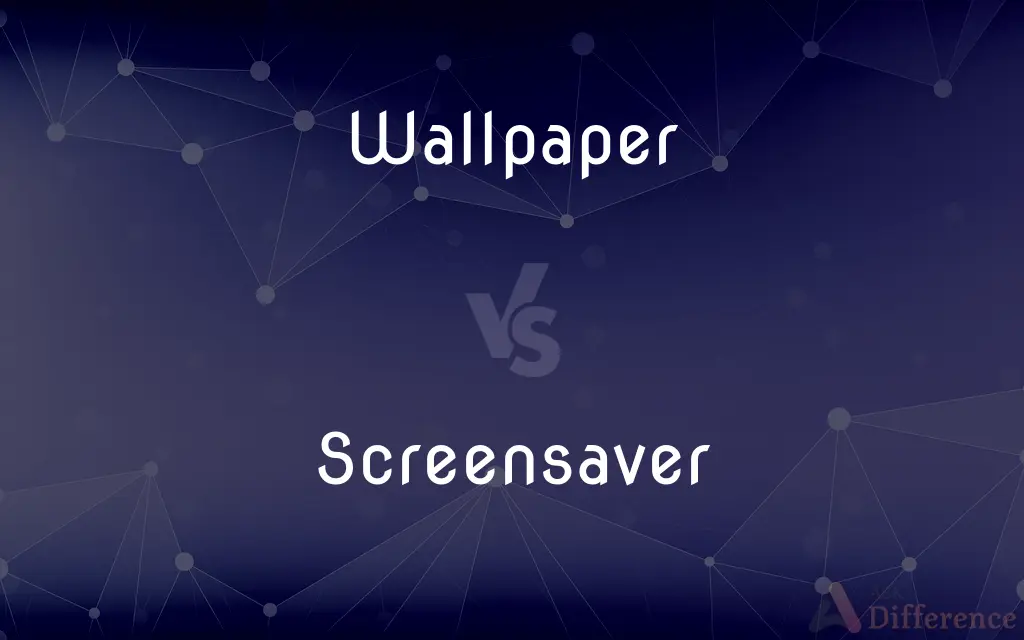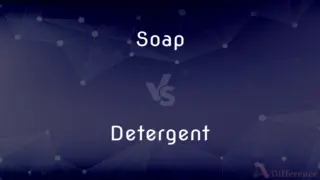Wallpaper vs. Screensaver — What's the Difference?
Edited by Tayyaba Rehman — By Maham Liaqat — Updated on March 31, 2024
Wallpaper decorates the desktop background, while a screensaver activates on inactivity, preserving screen health.

Difference Between Wallpaper and Screensaver
Table of Contents
ADVERTISEMENT
Key Differences
Wallpapers and screensavers are both visual elements used in digital devices but serve different purposes and functionalities. A wallpaper is a static or dynamic image set as the background on a device's desktop, visible whenever the desktop is not covered by open applications or windows. It allows users to personalize their digital workspace with images, patterns, or colors of their choice. Conversely, a screensaver is a moving image or sequence of images that activates after a computer or device has not been used for a predetermined period, originally designed to prevent screen burn-in on older monitors.
Historically, the distinction between wallpapers and screensavers was rooted in their primary functions—personalization vs. protection. Wallpapers have been used to customize the aesthetic of computer interfaces since the early days of graphical user interfaces (GUIs), providing a simple way for users to make their digital environment more personal and visually appealing. Screensavers, on the other hand, were developed to protect CRT and plasma screens from burn-in, a phenomenon where images statically displayed for long periods would permanently imprint onto the screen.
Technologically, wallpapers are relatively simple, requiring minimal system resources as they are static backgrounds that do not change until the user decides to update them. Modern systems also support dynamic wallpapers that change based on certain conditions, like time of day, but still use minimal resources. Screensavers, however, can be complex, featuring animations, slideshows of personal photos, or interactive elements that require more processing power and can even engage graphics hardware when displaying.
In terms of user interaction, wallpapers remain passive, serving solely as a backdrop that enhances the aesthetic of the user interface without affecting its functionality. Screensavers become active only after a period of inactivity, meant to temporarily take over the screen to either provide entertainment, display information, or protect the display.
The necessity and functionality of screensavers have evolved with advancements in display technology. With the advent of LCD and OLED screens, the risk of burn-in has significantly decreased, making screensavers more of a decorative or entertainment feature rather than a necessary protective measure. Meanwhile, the role of wallpapers as a means of personalization and aesthetic enhancement of digital devices remains constant.
ADVERTISEMENT
Comparison Chart
Purpose
Personalizes the desktop background
Prevents screen burn-in and entertains during inactivity
Functionality
Static or dynamic image displayed on the desktop
Activates after a period of inactivity with moving images
Historical Use
To customize the aesthetic of the computer interface
To protect CRT and plasma screens from burn-in
Technological Requirements
Minimal, uses static or dynamically changing backgrounds
More complex, may use animations or interactive elements
User Interaction
Passive, serves as a backdrop
Active, takes over the screen after inactivity
Compare with Definitions
Wallpaper
A background that changes based on certain conditions, like time of day.
His dynamic wallpaper mimicked the current sky, brightening during the day and darkening at night.
Screensaver
A screensaver that allows user interaction, often containing games or activities.
Her interactive screensaver allowed her to play a simple game without exiting the screensaver mode.
Wallpaper
A non-moving image used as a background on a digital display.
He preferred a simple static image as his wallpaper to minimize distractions.
Screensaver
A program that displays a moving image or pattern on a computer screen when it is on but not in use.
The aquarium screensaver turned her idle monitor into a virtual fish tank.
Wallpaper
A digital image or design used as a background on a computer screen or mobile device interface.
She chose a serene mountain landscape as her laptop's wallpaper for a calming effect.
Screensaver
Moving images or sequences used in screensavers to keep the screen dynamic.
The screensaver featured an animation of a journey through space, complete with passing stars and planets.
Wallpaper
The area of the screen where icons and windows are displayed over a personal image or color.
Changing the desktop background to a family photo made his computer feel more personal.
Screensaver
The original purpose of screensavers, to prevent static images from burning into display screens.
To avoid screen burn-in, he set his computer to launch a screensaver after five minutes of inactivity.
Wallpaper
The action of making something more personal by altering its appearance.
Personalization of her workspace included setting a custom wallpaper that matched her mood.
Screensaver
The modern role of screensavers, serving more for entertainment or decoration than for screen protection.
Although not necessary for LCD screens, the decorative feature of screensavers added an aesthetic touch to his setup.
Wallpaper
Wallpaper is a material used in interior decoration to decorate the interior walls of domestic and public buildings. It is usually sold in rolls and is applied onto a wall using wallpaper paste.
Screensaver
A screensaver (or screen saver) is a computer program that blanks the screen or fills it with moving images or patterns when the computer has been idle for a long time. The original purpose of screensavers was to prevent phosphor burn-in on CRT, plasma and OLED computer monitors (hence the name).
Wallpaper
Paper often colored and printed with designs and pasted to a wall as a decorative covering.
Screensaver
(software) A computer program that displays aesthetic patterns or images when the computer is not being used, originally intended to prevent screenburn.
I configured my screensaver to appear after only two minutes, because I enjoyed watching it so much.
Wallpaper
A picture or design displayed on the background of a computer screen or cellphone.
Screensaver
(proscribed) The background picture of a computer, smartphone, or similar mobile device.
Wallpaper
To cover with wallpaper.
Wallpaper
To decorate a wall or room with wallpaper.
Wallpaper
(uncountable) Decorative paper-like material used to cover the inner walls of buildings.
Wallpaper
(countable) A roll of such paper.
Wallpaper
(countable) A style or design of such material.
He is letting her select the wallpapers for the whole house.
Wallpaper
Anything that serves as a background or part of the surroundings.
Wallpaper
An image or tiled pattern used as the background of a computer desktop.
Wallpaper
Generic footage of a building or location that may be used in the background of a related news report.
Wallpaper
Gaudy mass-produced stamps, typically of little or no value and only produced for sale to collectors.
Wallpaper
A radio operator's collection of awards and QSL cards.
Wallpaper
(transitive) To cover (a wall, a room, etc) with wallpaper.
Wallpaper
A decorative paper for the walls of rooms
Wallpaper
Cover with wallpaper
Common Curiosities
Are screensavers still popular?
While less necessary for screen protection, screensavers remain popular for their decorative and entertainment value.
Can I use any image as a wallpaper?
Yes, any image can be set as a wallpaper, though it's best to use one that fits your screen's resolution for optimal display.
How do I disable my screensaver?
You can disable your screensaver through the display or personalization settings on your computer or device.
Can screensavers show personal photos?
Yes, many screensavers can cycle through a selection of personal photos as part of their animation.
Do I need a screensaver for my modern LCD monitor?
No, modern LCD monitors are less susceptible to burn-in, making screensavers more decorative than necessary.
What happens when a screensaver activates?
The device's screen displays moving images or patterns to prevent burn-in and entertain or inform the user during inactivity.
Why was screen burn-in a concern?
On older CRT and plasma screens, displaying the same image for long periods could permanently etch the image onto the screen.
Can wallpapers drain my device's battery?
Dynamic wallpapers may use more power than static ones, but the effect on battery life is generally minimal.
How can I change my wallpaper?
You can change your wallpaper through your device's settings, selecting from default images or your own photos.
How often should I change my wallpaper?
Changing your wallpaper is a matter of personal preference; there's no set frequency for when it should be updated.
Share Your Discovery

Previous Comparison
Makeup vs. Makeover
Next Comparison
Soap vs. DetergentAuthor Spotlight
Written by
Maham LiaqatEdited by
Tayyaba RehmanTayyaba Rehman is a distinguished writer, currently serving as a primary contributor to askdifference.com. As a researcher in semantics and etymology, Tayyaba's passion for the complexity of languages and their distinctions has found a perfect home on the platform. Tayyaba delves into the intricacies of language, distinguishing between commonly confused words and phrases, thereby providing clarity for readers worldwide.















































